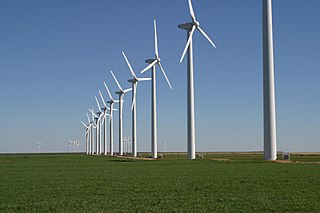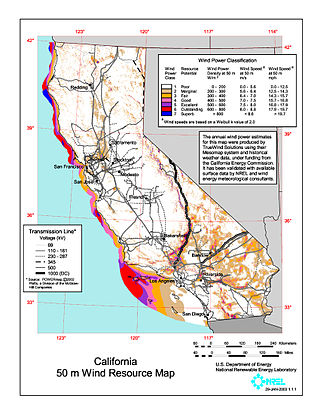
The University of Maine (UMaine) is a public land-grant research university in Orono, Maine. It was established in 1865 as the land-grant college of Maine and is the flagship university of the University of Maine System. It is classified among "R1: Doctoral Universities – Very high research activity".
Subsea technology involves fully submerged ocean equipment, operations, or applications, especially when some distance offshore, in deep ocean waters, or on the seabed. The term subsea is frequently used in connection with oceanography, marine or ocean engineering, ocean exploration, remotely operated vehicle (ROVs) autonomous underwater vehicles (AUVs), submarine communications or power cables, seafloor mineral mining, oil and gas, and offshore wind power.

Wind power is a branch of the energy industry that has expanded quickly in the United States over the last several years. From January through December 2022, 434.8 terawatt-hours were generated by wind power, or 10.25% of electricity in the United States. The average wind turbine generates enough electricity in 46 minutes to power the average American home for one month. In 2019, wind power surpassed hydroelectric power as the largest renewable energy source in the U.S.

Wind power in California had initiative and early development during Governor Jerry Brown's first two terms in the late 1970s and early 1980s. The state's wind power capacity has grown by nearly 350% since 2001, when it was less than 1,700 MW. In 2016, wind energy supplied about 6.9% of California's total electricity needs, or enough to power more than 1.3 million households. Most of California's wind generation is found in the Tehachapi area of Kern County, California, with some large projects in Solano, Contra Costa and Riverside counties as well. California is among the states with the largest amount of installed wind power capacity. In recent years, California has lagged behind other states when it comes to the installation of wind power. It was ranked 4th overall for wind power electrical generation at the end of 2016 behind Texas, Iowa, and Oklahoma. As of 2019, California had 5,973 megawatts (MW) of wind power generating capacity installed.

The European Marine Energy Centre (EMEC) Ltd is a UKAS accredited test and research center focused on wave and tidal power development, based in the Orkney Islands, UK. The centre provides developers with the opportunity to test full-scale grid-connected prototype devices in wave and tidal conditions.

A floating wind turbine is an offshore wind turbine mounted on a floating structure that allows the turbine to generate electricity in water depths where fixed-foundation turbines are not feasible. Floating wind farms have the potential to significantly increase the sea area available for offshore wind farms, especially in countries with limited shallow waters, such as Spain, Portugal, Japan, France and the United States' West Coast. Locating wind farms further offshore can also reduce visual pollution, provide better accommodation for fishing and shipping lanes, and reach stronger and more consistent winds.
There are a number of wind power projects in the state of Maine, totaling more than 900 megawatts (MW) in capacity. In 2020 they were responsible for 24% of in-state electricity production. In 2019, Maine had more wind capacity than the other five New England states combined, at 923 MW.
New York has 2,192 MW of installed wind power capacity as of 2022. Most of New York's wind power is located in upstate New York as onshore wind farms. New York has set a goal of developing 9,000 MW of offshore installed wind power capacity by 2035 that will power an estimated 6 million homes. As of October 2022, New York has five offshore wind farms in development with approximately 4,300 MW installed capacity.
Ørsted U.S. Offshore Wind is an offshore wind energy development group that is affiliated with Ørsted, a Danish firm. It is joint headquartered in Boston, Massachusetts and Providence, Rhode Island. As of 2019, it was involved in some of the largest offshore wind farm projects in the United States.

Offshore wind power or offshore wind energy is the generation of electricity through wind farms in bodies of water, usually at sea. There are higher wind speeds offshore than on land, so offshore farms generate more electricity per amount of capacity installed. Offshore wind farms are also less controversial than those on land, as they have less impact on people and the landscape.

Alpha Ventus Offshore Wind Park is a German offshore wind farm. This is Germany’s first offshore wind farm. It is situated in the North Sea, 45 kilometres (28 mi) north of the island of Borkum.

The U.S. state of Massachusetts has vast wind energy resources offshore, as well as significant resources onshore. The 2016 update to the states's Clean Energy and Climate Plan had a goal of reducing 1990 baseline greenhouse gas emissions levels by 25% by 2020. Current goals include installing 3,500 megawatts (MW) of offshore wind power in the state by 2035. However, as of Q4 2021 the state had only 120 MW of wind powered electricity generating capacity, responsible for generating 0.9% of in-state electricity production. The state has awarded contracts to two offshore projects, the 800 MW Vineyard Wind project and 804 MW Mayflower Wind project. Construction began on the Vineyard Wind 1 project on November 18, 2021, after a long fight for approval. Commonwealth Wind was selected for development in 2021, but the developer has attempted to cancel the project due to increased costs. There are eight projects planned for off the southern coast of Massachusetts, though some will deliver power to Rhode Island, Connecticut, and New York.

A tidal stream generator, often referred to as a tidal energy converter (TEC), is a machine that extracts energy from moving masses of water, in particular tides, although the term is often used in reference to machines designed to extract energy from run of river or tidal estuarine sites. Certain types of these machines function very much like underwater wind turbines, and are thus often referred to as tidal turbines. They were first conceived in the 1970s during the oil crisis.
The Oceanic Platform of the Canary Islands (PLOCAN) is a singular scientific and technological infrastructure (ICTS) aimed to accelerate the development of knowledge and technologies for the responsible and sustainable use of the ocean, in line with the United Nations Sustainable Development Goals and strategy of Blue Growth Strategy established by the European Union. It has been partially co-funded by the European Regional Development Fund (ERDF) under the ERDF Operational Programme for the Canary Islands 2007-2013 within Axis 1 "Development of the Knowledge Economy", priority theme 02, with a co-financing rate of 85%. PLOCAN is financed and managed by a consortium comprising 50% contributions from the Government of the Canary Islands and the Spanish National Government.

Block Island Wind Farm is the first commercial offshore wind farm in the United States, located 3.8 mi (6.1 km) from Block Island, Rhode Island in the Atlantic Ocean. The five-turbine, 30 MW project was developed by Deepwater Wind, now known as Ørsted US Offshore Wind.
Wind power is a form of renewable energy in South Korea with the goal of reducing greenhouse gas (GHG) and particulate matter (PM) emissions caused by coal based power. After two oil crises dating back to the 1970s, the South Korean government needed to transition to renewable energy, which encouraged their first renewable energy law in 1987.

The Advanced Structures and Composites Center is an independent research unit at the University of Maine that provides research, education, and economic development encompassing material sciences, manufacturing and engineering of composites and structures.

The VolturnUS is a floating concrete structure that supports a wind turbine, designed by University of Maine Advanced Structures and Composites Center and deployed by DeepCwind Consortium in 2013. The VolturnUS can support wind turbines in water depths of 150 ft (46 m) or more. The DeepCwind Consortium and its partners deployed a 1:8 scale VolturnUS in 2013. Efforts are now underway by Maine Aqua Ventus 1, GP, LLC, to deploy to full-scale VolturnUS structures off the coast of Monhegan Island, Maine, in the UMaine Deepwater Offshore Wind Test Site. This demonstration project, known as New England Aqua Ventus I, is planned to deploy two 6 MW wind turbines by 2020.
The University of Maine (UMaine) Deepwater Offshore Wind Test Site, located nearly 3 miles south west of Monhegan Island, Maine is available for use by commercial and non-commercial entities in partnership with the University of Maine, or the University of Maine itself, to research and develop ocean energy devices, such as floating wind turbines or wave energy converters.

Offshore wind power is in the early stages of development in the United States. In 2016, the United States Department of Energy estimated that the country has a gross resource potential of 10,800GW of offshore wind capacity, with a "technical" resource potential of 2,058GW. Offshore wind projects are under development in wind-rich areas of the East Coast, Great Lakes, and Pacific coast. The first commercial offshore wind farm, Block Island Wind Farm, began operation in 2016. As of 2017, about 30 projects totaling 24 gigawatts (GW) of potential installed capacity were being planned.













